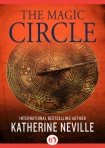The Magic Circle Katherine Neville (top 100 novels of all time TXT) 📖

- Author: Katherine Neville
Book online «The Magic Circle Katherine Neville (top 100 novels of all time TXT) 📖». Author Katherine Neville
In our week of scheduled meetings, Wolfgang and I traversed a broad swath of central Russia, visiting facilities and meeting with groups and individuals that worked in various capacities within the nuclear field, and I discovered the Soviet government’s gravest worry wasn’t the operational safety of their power plants but something I myself might be uniquely placed to deal with: the security of nuclear materials, especially those recycled from fuels and weaponry. Much of these, in the case of the Soviet Union, happened to be located outside the Russian Federal Republic proper. That’s where I came into the picture.
For almost five years, Olivier and I had been constructing a database designed to locate, classify, and monitor toxic, hazardous, and transuranic waste that had been produced by segments of the U.S. government and related industries. The project involved many groups around the country and the world, and we all shared expertise in our own Yankee version of glasnost-perestroika. We interfaced with the IAEA, and with databases from Monterey to Massachusetts that monitored trade in nuclear materials, equipment, and technology. But our efforts were just beginning to explore the surface of a very deep wound.
The secrecy and mistrust of the now waning Cold War period, I soon found, had left scars that were hard to erase—especially on Mother Earth. The horror stories were many: for years the motto in the nuclear field had been: The left hand knoweth not what the right hand doeth. The military shoved waste into landfill where housing subdivisions were later built; liquid waste from reactors was injected into the aquifers of rivers and such. But our Western military-industrial predecessors seemed lily white, I learned, compared with their counterparts in Russia these past forty years.
While we’d long wrangled over how to locate and dig up waste—not to mention what to do with it once we found it—I learned, in my week of traveling Russia, that the Soviets had Satan ICBMs and Bear H bombers and thousands of stockpiled strategic warheads. They had numerous storage facilities for spent fuel assemblies; gaseous diffusion and laser isotope plants for uranium enrichment; open pit and slurry mines and in situ leaching of deep-seated uranium deposits. Dumping in the Arctic and Pacific of tritium and zirconium, it seems, had been going on for decades.
There were roughly 900,000 people employed in—and at least ten cities solely dedicated to—the Soviet nuclear industry. There were more than 150 sites where fissile materials were used or produced, and plans on the books to double the number of commercial reactors within the next twenty years. And that was only the beginning.
The problem that proved the biggest burr under the saddle, as Olivier might say, was Central Asia—the area called, in the Turkic tongues of the region, Ortya Asya—which included the five largely Islamic republics of Kazakhstan, Kyrgyzstan, Uzbekistan, Tajikistan, and Turkmenistan. When Karl Marx said religion was the opiate of the masses, he forgot how deeply the drug coursed in the veins of humanity—and that rhetoric had never proven any antidote. Russia’s ten-year war of aggression against her Islamic neighbor Afghanistan, “the Russian Vietnam,” had only exacerbated this age-old spiritual-material schism.
To further fuel the fundamentalist fire, the Russian name for this same region, Sredniya Aziya, referred to only four of the republics—excluding Kazakhstan, which, with its large ethnic Russian population, they considered part of Russia. The Soviet Union’s nuclear test sites were located in Kazakhstan, which shared a border with Xinjiang—the former Chinese Turkestan, with its own Islamic population—where China’s nuclear testing had taken place, at Lop Nur in the high desert, since 1964. The whole area was a powder keg.
Russian operations outside the USSR looked no better. There were weapons arsenals and mining and fuel production centers in Czechoslovakia and Poland. From the 1970s, Russia had supplied nuclear fuel to countries like Egypt, India, Argentina, and Vietnam, as well as highly enriched uranium to research reactors in Libya, Iraq, and North Korea. Yet there wasn’t a single customs post in the entire USSR set up to measure the radiation level of shipments on a regular basis.
Given this picture, it didn’t take a stretch of the imagination to figure out why the Russians were hopping on coals. Clearly, Western expertise hadn’t arrived a moment too soon. But when it came to sandbagging dikes, my philosophy had always been better late than never.
The mythical Pandora had opened her fabled box so long ago, the moral of her tale seemed lost. She might have released on the world all the evils a vengeful Zeus could dream up. But as Sam said, maybe we’d been reading the maps wrong. After all, one thing had still stuck in the box that never escaped: hope. Looking at the picture from a different perspective, maybe hope really was still waiting for us inside the box. At least, so I hoped.
We agreed with our Soviet fellow nukes to enter into the new spirit of problem-sharing. What with the recent atmosphere of openness and cooperation, Soviet scientists were lately permitted to travel outside the Iron Curtain as never in the past. Before Wolfgang and I left the country, we made dates for follow-up contacts—and I’d even collected a bagful of those new elitist items that had been pressed on me all week: business cards.
The Vienna airport was nearly deserted by the time our plane arrived late. We’d already had a close connection and thought we might miss our flight. But the last plane to Paris was held for minor repairs and hadn’t been boarded, so we checked in. While Wolfgang waited with the others for





Comments (0)